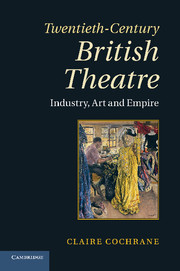Book contents
- Frontmatter
- Contents
- Acknowledgements
- Introduction
- Chapter 1 The topography of theatre in 1900
- Chapter 2 Structures of management
- Chapter 3 The profession of acting
- Chapter 4 The amateur phenomenon
- Chapter 5 The topography of theatre in 1950
- Chapter 6 The business of theatre
- Chapter 7 The changing demographic of performance
- Chapter 8 The topography of theatre in 2000
- Conclusion
- Notes
- Select Bibliography
- Index
Chapter 5 - The topography of theatre in 1950
Published online by Cambridge University Press: 05 November 2011
- Frontmatter
- Contents
- Acknowledgements
- Introduction
- Chapter 1 The topography of theatre in 1900
- Chapter 2 Structures of management
- Chapter 3 The profession of acting
- Chapter 4 The amateur phenomenon
- Chapter 5 The topography of theatre in 1950
- Chapter 6 The business of theatre
- Chapter 7 The changing demographic of performance
- Chapter 8 The topography of theatre in 2000
- Conclusion
- Notes
- Select Bibliography
- Index
Summary
If the built landscape in 1900 was the product of nations-wide industrial prosperity and imperial confidence, in 1950 the scars inflicted by wartime bombing and the legacy of industrial decay from the 1930s were still all too visible. To be sure additional constructed layers to the environment bore witness to the industrial initiatives and housing developments of the interwar years, and there were some new theatres, but the spatial evidence provided by the topographical concentration of new build showed the geographical and demographic consequences of economic and social inequality. Lack of investment and maintenance in the worst-affected areas had resulted in the dereliction of physical infrastructure and the loss of population to more prosperous parts of the country. Patterns of internal migration formed and reformed as circumstances changed, but the drift towards the Midlands and the South-East of England in search of new industries continued.
In Wales, for example, between 1939 and 1941, it appeared that the 1930s’ haemorrhage of the population had reversed as at least 200,000 immigrants arrived seeking a safe haven from the war. In the 1951 census, however, it was shown that 649,275 people born in Wales were then living in England and of those 190,722 were resident in the South-East. The Irish were still coming to Britain at the rate of 60,000 a year after 1945. While the creation of the Irish Free State in 1921 had meant that as a geopolitical construct Great Britain had physically shrunk, Eire’s economic dependence on British markets made, as R. F. Foster pointed out, ‘nonsense of Irish “sovereignty”’.
- Type
- Chapter
- Information
- Twentieth-Century British TheatreIndustry, Art and Empire, pp. 139 - 170Publisher: Cambridge University PressPrint publication year: 2011



